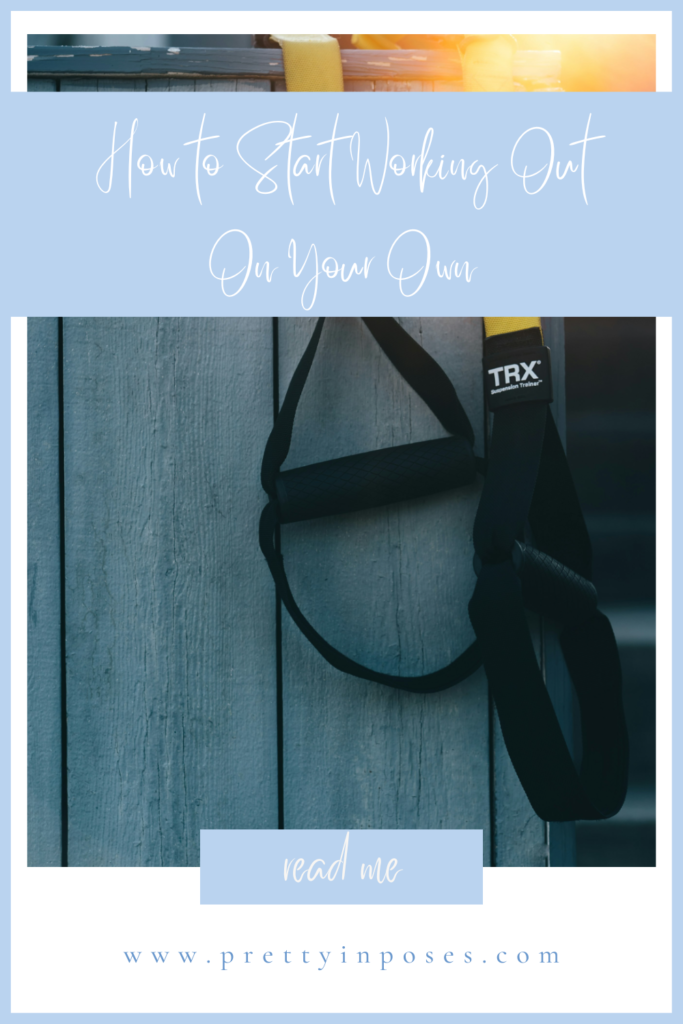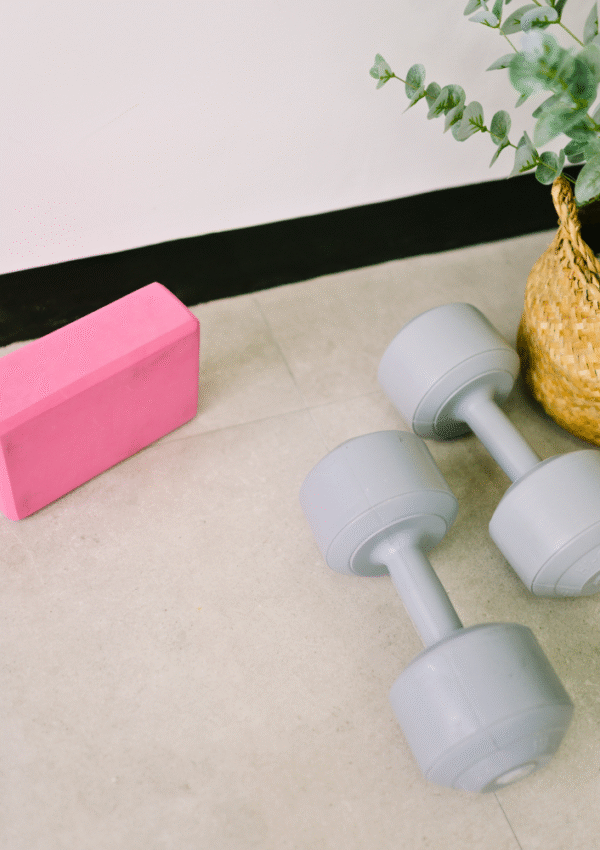The decision to adopt a fitness routine can be both exciting and empowering.
After all, what could be better than taking charge of your health?
At the same time, you may also feel a sense of anxiety if not downright intimidation at the idea of exercising, particularly if you’ve never been physically active.
But this is all normal so there’s absolutely no need to overwhelm yourself.
In this post, you’ll learn how to start working out on your own in just five simple steps.
How to Start Working Out On Your Own
Before beginning any fitness regimen, get yourself fully checked out and cleared by a licensed physician.
This preliminary step will ensure a smoother transition into your new active lifestyle.
Once you’ve received the “OK” from your doctor, it’s time to move through the steps below.
Step 1: Set A Goal
Goal setting, especially in fitness, is paramount to achieving success. They’re the destination for your journey, providing you with a sense of purpose and direction.
Crafting a goal that is specific and realistic offers an aim to strive for and something to measure your progress against.
As you begin the process of setting goals, ponder what it is you hope to accomplish and try to really narrow down your desire.
Avoid making vague statements such as “I want to lose weight,” or “I want to shed a few pounds before summer,” since this lacks the specificity that effective goal setting requires.
Instead, strive for more tangible objectives like “I want to lose 10 pounds in six months just before my wedding this fall.”
Connecting a specific and realistic goal to an emotional event that includes a time frame helps to make it concrete and attainable.
To strengthen your commitment, try jotting them down on paper.
A study found that people were 42% more likely to achieve their goals if they wrote them down.
Step 2: Take Your Measurements
The point of this next step is to establish a baseline to keep track of any weight loss or muscle gain you experience over time.
Plotting your progress throughout your journey can be invaluable because it allows you to view what’s working and what isn’t so you can correct course.
But there will be more on this later, for now, understanding how to take your measurements is the primary focus.
First, you’ll need to acquire body measuring tape, a notepad, something to write with, and ideally, a full-length mirror.
Next, take a relaxed, natural stance before the mirror and begin measuring.
Bust: Gently measure around your chest along the nipple line.
Waist: Wrap the tape around your belly button and write the number.
Hips: Take the tape around the widest part of your butt then jot down the number.
Thighs: Position the tape around the biggest part of each thigh and measure.
Arms: Measure the fullest part of your arm above the elbow.
Calves: Note the measurement around the fullest part below the knee.
Feel free to continue with additional measurements, but it’s not necessary.
When using the tape, make sure that it lies flat against the skin, and remember to measure both limbs. The numbers aren’t always the same and that’s completely fine.
Lastly, measure in centimeters rather than inches.
Step 3: Assess Yourself
The third step involves a self-assessment which is important for evaluating your current fitness level.
It doesn’t have to be complicated or technical, but it should help you assess your range of motion, your ability to perform basic exercises like squats and push-ups as well as balance.
Let your test consist of a basic pushing movement, pull, squat, hinge, lunge, core stability, rotation, flexibility, cardio, balance, and coordination.
It’s not necessary to track every detail unless you’re training to become a competitive athlete but it is good to have a general idea of your skill set.
Don’t worry too much about any limitations as most exercises can be modified when needed. Here is a sample self-assessment you can use:
Push-ups (10 for men, 5 for women)
Squats (15 to 20 for men, 10 to 15 for women)
Plank (20 sec to 30 sec for men, 10 sec to 20 sec for women)
Cardio-jogging, jump rope, burpees, etc… (5 minutes)
Sit and Reach (15 sec to 30 sec)
Single-Leg Stand (30 sec on each leg. Older people 10 sec to 15 sec)
Step 4: Build Your Program
After taking measurements and assessing your fitness ability, it is time to make your program.
When building your regimen, there are many aspects to consider. To simplify the process, you can try crafting a series of questions to answer such as:
Do you prefer high-intensity training like sprinting or would you be more comfortable performing low-intensity training like walking?
What type of workouts do you enjoy? (i.e. strength training, cardio, HIIT, circuit training, CrossFit, bodyweight, yoga, etc,…) Feel free to mix and match.
What days and times work best for you to exercise? Will you include rest days?
How many sets and reps can you complete during your workouts? How long will you rest in between?
Where do you intend to exercise? At home, outside, at the gym?
How often will you switch up your workout routine? Monthly or every couple of months?
How many different exercises will you include in each workout? How long will your workouts be?
Will you use equipment and what do you plan to wear?
How will your diet change to help you achieve your fitness goals? How much protein, carbs, fat, and fiber will you need? Also, what will your water intake look like?
By no means is this an exhaustive list, but hopefully, you understand the considerations involved in writing a fitness program. Answering these questions will certainly assist in your effort to build a regimen that’s right for you.
Step 5: Track Your Progress
This step was mentioned earlier but includes more than keeping track of your weight gains and losses.
The details you provide especially in the first several months of your training are critical for developing a solid fitness routine and accomplishing your goals faster.
You should record as much as possible about your fitness performance, noting any improvements and setbacks per session.
Write down how you feel after every workout and meal to make adjustments as needed.
Monitor your progress every 6 to 8 weeks and consider changing your routine to continue challenging yourself.
Extra Tips
That is more or less all you need to know for how to start working out on your own but if you want a little extra, here are some tips.
Warmup, Cool down, Stretch
It’s good to warm up for five to ten minutes before any exercise routine as it will prepare the body for physical activity. Likewise, spending an equal amount of time after the workout to gradually bring yourself back to a restful state is also beneficial. To further support your range of motion, recovery, and injury prevention, stretch for a few minutes at the end of your session. All these movements will enhance your overall fitness.
Drink Fluids
As your physical activity increases so should your intake of fluids. You lose a lot of water through sweat so you must maintain your hydration levels. This will improve your concentration and performance during workouts while boosting endurance, regulating body temperature, and preventing heart rate spikes.
Listen to Body
Exercise is challenging and it should be. However, it is imperative to understand the difference between enduring a tough workout and overexerting yourself. You will experience some soreness which is normal but you should never feel pain. Listen to what your body is telling you, if you’ve reached your physical limit, stop. This will prevent the risk of injury.
Be Consistent
One of the biggest hurdles you’ll face in your fitness journey is showing up for yourself consistently. However, if you intend to succeed, then consistency is the key. Try to set aside time every day for your workouts, preferably at the same time on the same days each week. This will improve your discipline and devotion to your training.
Pushing Through
There’s a lot of research that speaks to the benefits of motivation, but having a “why” is not always enough. Regardless of the reason you started your fitness journey, there will be days when you just don’t want to exercise. Perhaps, you’ve had a bad day or you’re just not feeling up to it. Do it anyway. As long as you feel fine physically, push through these sentiments. Most of the time, you’ll find they go away after you begin the workout.
Reward Yourself
Use rewards to treat yourself for being consistent or for rising to meet challenges. It doesn’t matter if it’s only buying a cup of coffee or eating breakfast, having something to look forward to after your workout provides positive reinforcement and strengthens your commitment to achieving your goals.
Start Small
It may be tempting to turn on a fitness video and start exercising but that may not be the best option. Increasing your intensity or difficulty level gradually allows for more sustainable progress and reduces your risk of injury. Begin with exercises you know you can do and figure out simple yet effective ways to challenge yourself.
Get a Support Group
Building a network of support whether it be a group of friends, family members, or other fitness enthusiasts breeds accountability and encouragement. Find a fitness partner(s) to work out with and share your success or pitfalls. They can also provide solid advice and motivation to stay on top of your goals.
Exercising on Your Own
That was our post on how to start working out on your own.
It doesn’t have to be daunting or intimidating.
Go through the simple steps outlined in this post and you’ll be sure to reach your fitness goals in no time!







Leave a Reply